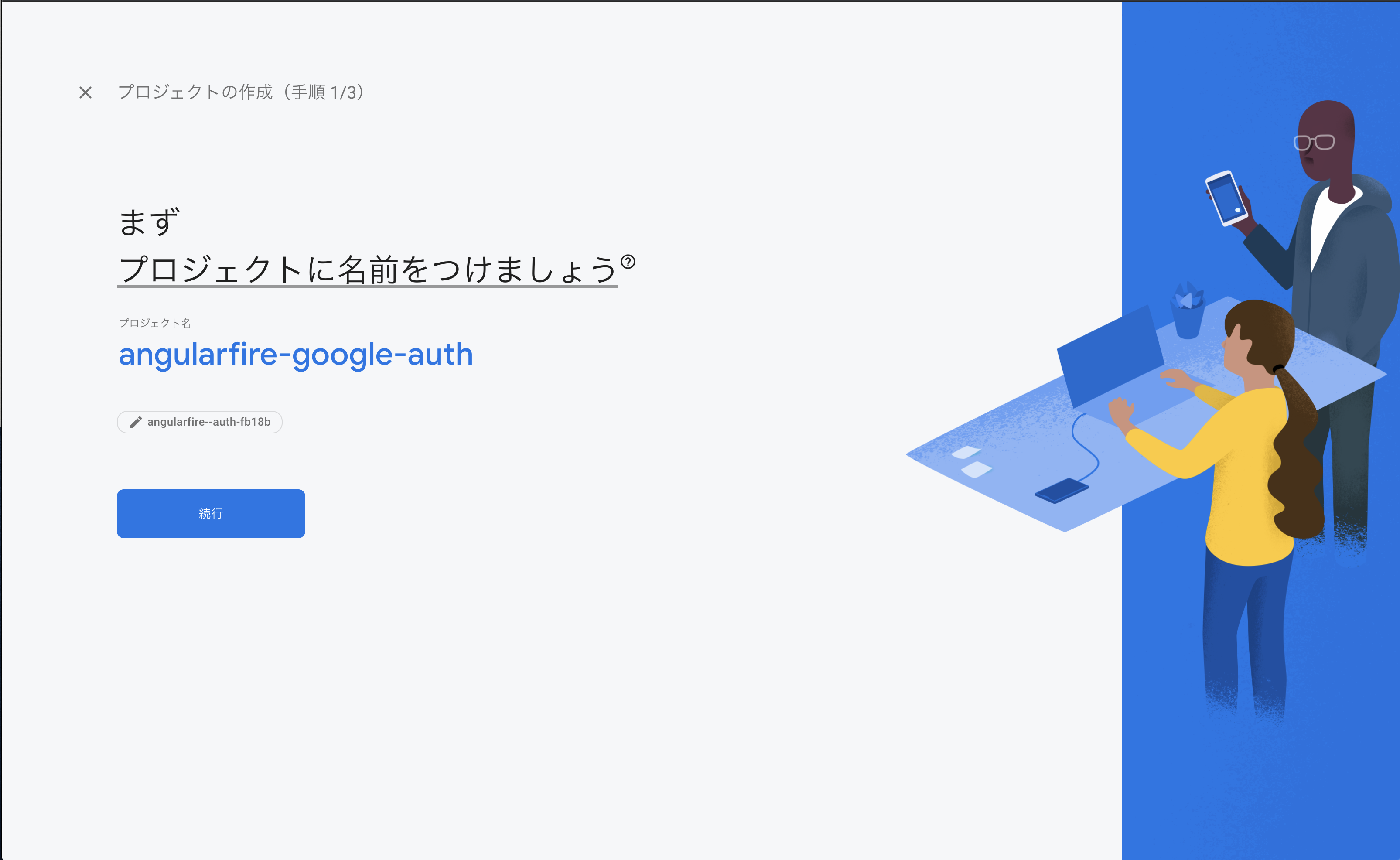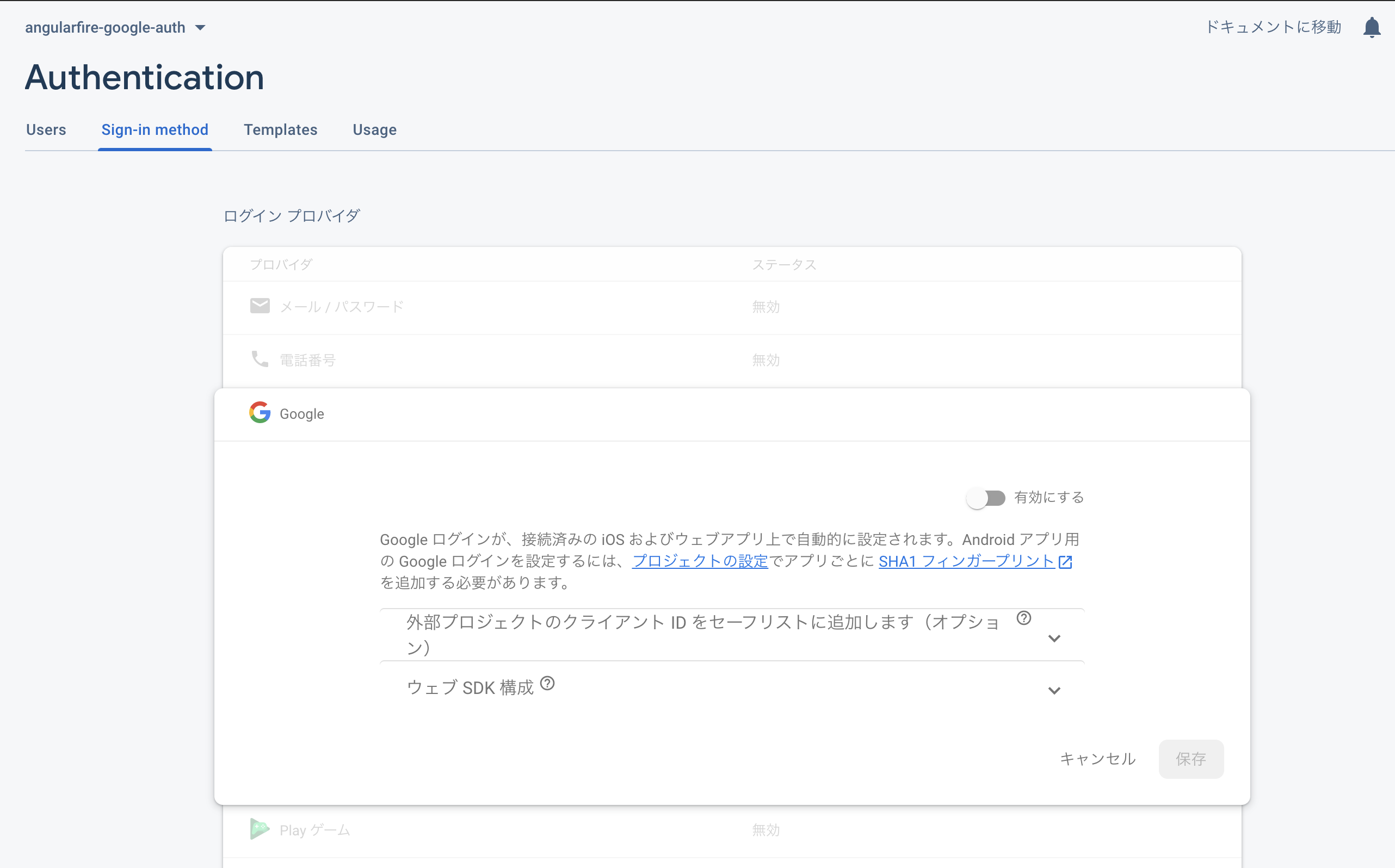AngularでGoogleログイン認証をする
Googleアカウント認証の実装メモ。初zenn投稿です🎉
実装内容
- Firebase AuthenticationによるGoogle認証
- アカウント情報をFirestoreに保存
- Guardで認証の確認
環境
- macOS Catalina
- Angular CLI: 11.0.6
- Node: 12.16.3
Firebaseでプロジェクト作成
プロジェクト作成
コンソールから新規作成する。
今回は、angularfire-google-authとした。続行するとGoogleアナリティクスについての設問が出てくるがどんどん続行する。

Firebase Authentication
左サイドメニューのAuthenticationからログインプロバイダを選択。
Googleを有効にする。

これで🆗
config keyの発行
左サイドメニューの プロジェクトの概要 > プロジェクトを設定 > マイアプリ
Webを選択し、任意のアプリ名を入力する。
Firebase SDK snippetからfirebaseConfigを確認することが出来る。確認したkeyは、Angularの環境設定ファイルに記述する(後述)。
AngularCLIでテンプレート作成
AngularCLIのインストールをしていない場合→npm install -g @angular/cli
ng new angularfire-google-auth
# いろいろ聞かれる
? Do you want to enforce stricter type checking and stricter bundle budgets in the workspace? (y/N) N
? Would you like to add Angular routing? (y/N) y
とりあえずAngular routerが入っていれば🆗
パッケージのインストール
npm install @angular/fire firebase --save
実装
作成したテンプレートを修正してログインするところまで実装する。
Angularの環境設定ファイルにfirebase keyを追加する
発行したfirebaseConfigをsrc/app/environment.tsに記述。
export const environment = {
production: false,
firebase: {
apiKey: '#####',
authDomain: '#####',
projectId: '#####',
storageBucket: '#####',
messagingSenderId: '#####',
appId: '#####',
measurementId: '#####'
}
};
使用するモジュールをインポート
firebase keyを用いて初期化もしている。
型定義
Firestoreに保存するデータの型を定義する。以下コマンドでinterfaceを作成。
ng g interface services/user
export interface User {
uid: string;
email: string;
photoURL?: string;
displayName?: string;
}
認証周りのサービス
ここでサインインやサインアウト、ログイン状態の確認を実装する。まずは、サービステンプレートの作成。
ng g service services/auth
auth.service.ts
import { Injectable } from '@angular/core';
import { Router } from '@angular/router';
import firebase from 'firebase/app';
import { AngularFireAuth } from '@angular/fire/auth';
import { AngularFirestore, AngularFirestoreDocument } from '@angular/fire/firestore';
import { Observable, of } from 'rxjs';
import { switchMap } from 'rxjs/operators';
import { User } from './user.model';
@Injectable({
providedIn: 'root'
})
export class AuthService {
user$: Observable<User>;
constructor(
private angularFireAuth: AngularFireAuth,
private angularFireStore: AngularFirestore,
private router: Router
) {
this.user$ = this.angularFireAuth.authState.pipe(
switchMap(user => {
// Logged in
if (user) {
return this.angularFireStore.doc<User>(`users/${user.uid}`).valueChanges();
} else {
// Logged out
return of(null); // 空のObservableを返す
}
})
);
}
async googleSignin() {
const provider = new firebase.auth.GoogleAuthProvider();
const credential = await this.angularFireAuth.signInWithPopup(provider);
return this.updateUserData(credential.user);
}
async signOut() {
await this.angularFireAuth.signOut();
this.router.navigate(['/']);
}
private updateUserData(user: User) {
// ログイン痔にfirestoreにuser dataを追加する
const userRef: AngularFirestoreDocument<User> = this.angularFireStore.doc(`users/${user.uid}`);
const data = {
uid: user.uid,
email: user.email,
displayName: user.displayName,
photoURL: user.photoURL
}
return userRef.set(data, { merge: true })
}
}
参考サイトとライブラリバージョンが異なるのか多少メソッドが異なるところがある。
コンポーネントに繋ぎこむ
src/app/app.component.tsにAuthServiceをimport
app.component.ts
import { Component } from '@angular/core';
import { AuthService } from './services/auth.service';
@Component({
selector: 'app-root',
templateUrl: './app.component.html',
styleUrls: ['./app.component.scss']
})
export class AppComponent {
constructor(public auth: AuthService) {}
}
app.component.htmlも編集してボタン等配置する。
app.component.html
<div *ngIf="auth.user$ | async as user; else login">
<pre>
{{ user | json }}
</pre>
<hr>
<button class="button" (click)="auth.signOut()">SignOut</button>
</div>
<ng-template #login>
<button class="button" (click)="auth.googleSignin()">Login with Google</button>
</ng-template>
<router-outlet></router-outlet>
ng serveしてhttp://localhost:4200 を見るとボタンが表示されてログインが出来る。ログインが成功するとjsonが表示される。
ログイン時のみ表示可能なページを作成
Guardを使用することでログインしているユーザかどうかを判定する。これにより認証がされていないユーザのアクセス可能なページを制限することが可能になる。
ng g guard auth
auth.guard.ts
import { Injectable } from '@angular/core';
import { CanActivate, ActivatedRouteSnapshot, RouterStateSnapshot, Router } from '@angular/router';
import { Observable } from 'rxjs';
import { AuthService } from './auth.service';
import { tap, map, take } from 'rxjs/operators';
@Injectable({
providedIn: 'root'
})
export class AuthGuard implements CanActivate {
constructor(private auth: AuthService, private router: Router) {}
canActivate(next, state): Observable<boolean> {
return this.auth.user$.pipe(
take(1),
map(user => !!user),
tap(loggedIn => {
if (!loggedIn) {
console.log('access denied!!!!!');
this.router.navigate(['/']);
}
})
)
}
}
メモはこれで終わり。ドキュメントや参考記事が多いのでお手軽だった。
他のログイン認証についても試していく予定。
参考
Discussion